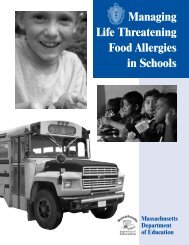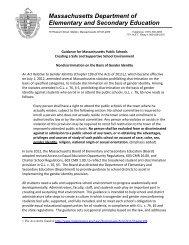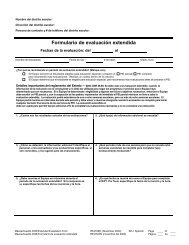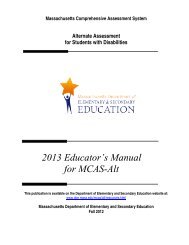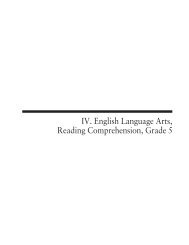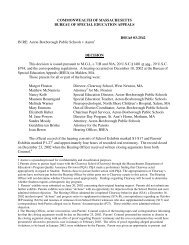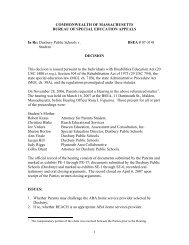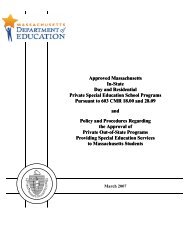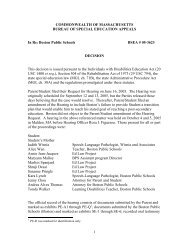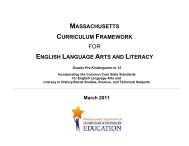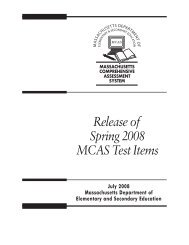Two Year Follow-up Review for Matthew J. Kuss Middle School
Two Year Follow-up Review for Matthew J. Kuss Middle School
Two Year Follow-up Review for Matthew J. Kuss Middle School
Create successful ePaper yourself
Turn your PDF publications into a flip-book with our unique Google optimized e-Paper software.
<strong>Follow</strong>-<strong>up</strong> <strong>Review</strong> Report, Spring 03 <strong>Kuss</strong> <strong>Middle</strong> <strong>School</strong>, Fall River, MA page 6<br />
The grade 6 mathematics MCAS test was first administered in 2001. In 2001, one percent of<br />
Regular Education students at the <strong>Kuss</strong> <strong>School</strong> scored in the Advanced category, four percent in<br />
Proficient, 26 percent in Needs Improvement, and 70 percent scored in Warning. In 2002, two<br />
percent of students scored at the Advanced level, and 15 percent scored at the Proficient level.<br />
Thirty-two percent of students in this gro<strong>up</strong> scored in Needs Improvement and 52 percent were<br />
at Warning. These students’ per<strong>for</strong>mance in Cycle II lags behind the District’s overall<br />
per<strong>for</strong>mance. The per<strong>for</strong>mance gaps are much wider when the <strong>Kuss</strong> <strong>School</strong>’s Regular Education<br />
students are compared to statewide per<strong>for</strong>mance at this grade level.<br />
The per<strong>for</strong>mance of Regular Education students in grade 8 in mathematics over the last four<br />
years has not followed a clear pattern. In 1999, one percent of Regular Education students scored<br />
at the Advanced level, four percent in Proficient, 26 percent in Needs Improvement and 69<br />
percent at Warning. In 2000, eight percent of students scored Proficient, 21 percent scored at the<br />
Needs Improvement level, and 71 percent at Warning. In the first year of Cycle II, nine percent<br />
of the students tested per<strong>for</strong>med at the Proficient level, 39 percent were in Needs Improvement,<br />
and 52 percent scored at Warning. In 2002, one percent of students scored in the Advanced<br />
category, four percent in Proficient, 32 percent in Needs Improvement and 63 percent in<br />
Warning.<br />
The per<strong>for</strong>mance of Regular Education 8 th grade students in mathematics at the <strong>Kuss</strong> <strong>School</strong><br />
resembles that of their counterparts in the district. However, to align student per<strong>for</strong>mance at the<br />
school with statewide per<strong>for</strong>mance, the proportion of students scoring at the Warning level will<br />
need to be reduced by at least half, and the percentage of those proficient tripled. See Table 1<br />
below.<br />
Table 1. Comparing Regular Education Students’ Per<strong>for</strong>mance in Mathematics in grade 8 (1999-2002)<br />
Regular Ed. 1999 2000 2001 2002<br />
<strong>School</strong> District State <strong>School</strong> District State <strong>School</strong> District State <strong>School</strong> District State<br />
Advanced 1 0 7 0 1 12 0 1 13 1 1 13<br />
Proficient 4 7 26 8 9 27 9 9 27 4 8 26<br />
Needs 26 32 34 21 28 29 39 37 37 32 29 36<br />
Improvement<br />
Warning 69 61 33 72 62 32 52 54 23 63 62 25<br />
Special Education<br />
Special Education students tested at the grade 6 level in Cycle II did not meet the minimum<br />
sample size in 2001. In 2002, five percent of the sixth grade Special Education students at <strong>Kuss</strong><br />
rated a Needs Improvement classification, and the remaining 95 percent scored in the Warning<br />
category.<br />
The per<strong>for</strong>mance of Special Education students at the <strong>Kuss</strong> <strong>School</strong> in grade 8 has fluctuated<br />
widely over the last four years. In 1999, all Special Education students were at the Warning<br />
level in mathematics. In 2000, three percent scored at the Needs Improvement level and 97<br />
percent at Warning. In 2001, 40 percent were at the Needs Improvement level and 60 percent at<br />
Warning. In 2002, all but 10 percent who scored at the Needs Improvement level, per<strong>for</strong>med at<br />
the Warning level. The participation rates of <strong>Kuss</strong> eighth grade Special Education students<br />
Massachusetts Department of Education



